|
|
|
Sort Order |
|
|
|
Items / Page
|
|
|
|
|
|
|
| Srl | Item |
| 1 |
ID:
141365
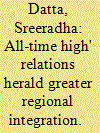

|
|
|
|
|
| Summary/Abstract |
India and Bangladesh have made significant progress on several matters, all of which certainly merit applause. However, more interesting is the progress made on sub-regional cooperation in the region. The bilateral connectivity will, no doubt, expand in the region, with other states like Nepal and Bhutan benefitting from the access to two Bangladeshi ports as well as trade through the Indian corridor. Matters of water sharing, trade and commerce, including energy, will soon go much beyond the bilateral prism. The recent motor vehicle agreement signed between Bangladesh, Bhutan, India and Nepal is just a first but critical step towards a sub regional initiative that has gathered momentum amongst the South Asian neighbours. Certainly bilateral matters will continue to dominate and be seen as more critical between any two neighbours. The sub-regional cooperation process will ensure that incentives to find resolutions to certain outstanding bilateral matters will assume greater salience.
|
|
|
|
|
|
|
|
|
|
|
|
|
|
|
|
| 2 |
ID:
187456
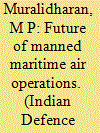

|
|
|
| 3 |
ID:
034535
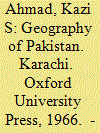

|
|
|
|
|
| Publication |
Karachi, Oxford University Press, 1966.
|
| Description |
216p.Hbk
|
|
|
|
|
|
|
|
|
|
|
|
Copies: C:1/I:0,R:0,Q:0
Circulation
| Accession# | Call# | Current Location | Status | Policy | Location |
| 002742 | 915.491/AHM 002742 | Main | On Shelf | General | |
|
|
|
|
| 4 |
ID:
128114
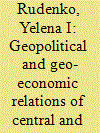

|
|
|
|
|
| Publication |
2013.
|
| Summary/Abstract |
According to many experts on ancient and Medieval history of contacts between Central and South Asian regions in previous centuries, including Janet Rizvi, "the trade from Mysore to Central Asia presented no difficulties". Obviously, not all trades who come to India from Central Asia alongwith their caravans reached coastal part of subcontinent, but rather chose as their final destination, the major cities of North India.
|
|
|
|
|
|
|
|
|
|
|
|
|
|
|
|
| 5 |
ID:
126595
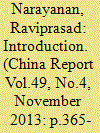

|
|
|
|
|
| Publication |
2013.
|
| Summary/Abstract |
It is not often that one comes across academic opinions from Taiwan on issues local and global. This special issue of the China Report titled 'Taiwanese Engagement with the Indo-Pacific' details perceptions of leading scholars from reputed universities and think-tanks in Taiwan on strategic and security issues faced by the island. The discourse on Taiwan's need for security in a constantly changing world is an intensive and engaging arena that throws up voluble insights into the pace, depth, variety and intensity of Cross-Strait relations, engagement with the United States, policy on South China Sea disputes, contestations of external policy in the internal political sphere and relations with other stakeholders of the international system including India.
|
|
|
|
|
|
|
|
|
|
|
|
|
|
|
|
| 6 |
ID:
132007


|
|
|
|
|
| Publication |
2014.
|
| Summary/Abstract |
William Eleroy Curtis was central to the creation of the Pan-American movement in the United States. As a lobbyist and bureaucrat, he helped organize the first Inter-American Conference in 1889-1890. As a journalist he became a leading "expert" on Latin America. This article uses Curtis to explore the relationship between Pan-Americanism and empire. Before 1898, Curtis sought only expanded trade, not territory for the United States. However, to explain why the country would "naturally" come to dominate Latin American markets, he depicted Latin Americans as backward yet capable of uplift through the infusion of U.S. knowledge and capital. He thus justified hemispheric control and helped U.S. Americans envision empire as a tutelary imperative. When Curtis supported territorial expansion in 1898 he did so in the language of civilizing mission rather than market aggrandizement. In combining narratives of difference and equality, Pan-Americanism served Curtis as a transitional imperial ideology.
|
|
|
|
|
|
|
|
|
|
|
|
|
|
|
|
| 7 |
ID:
129406
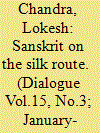

|
|
|
|
|
| Publication |
2014.
|
| Summary/Abstract |
Sanskrit was the mind of Sill: Route, at one with the sky-void and the spring mist, the live hues of sensibility dyed in eternity. a bridge of dreams floating across eloudless skies of the sands, a symbol system that made the heart pure, the spring blossoms of the devout. It was the realisation of Truth, and the very being of Values. Sanskrit was to enter the profound, the inner depths. Today. torn Sanskrit fragments
from the silk Route reflect the savagery of fundamentalism. the furious wrath of apostasy. They remind me of ten million Buddhist Sutras being mthessly committed to fire in Buryatia. Mongolia. Kalrnykia.
and Tuva. As Lama Sandaa related to me with tears ?owing across his withered face of eithty years: 'I was forced to destroy what I revered, admired and had faith in. There's no torture more terrible than that'.
Likewise. these Sanskrit fragments are tears of time. Scholars sit in their silence, forgetting the hours that follow each either, to identify tiny and large feagments as if perfecting a diamond. They are ratnaktita or heaps of jewels in the words of Prof. Karashima. We are pilgrims to amazing centuries that have ?ourished and vanished.Vedic Shaivism
|
|
|
|
|
|
|
|
|
|
|
|
|
|
|
|
| 8 |
ID:
126634
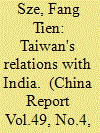

|
|
|
|
|
| Publication |
2013.
|
| Summary/Abstract |
India's rise' has been the main driver of the India-Taiwan relationship over the recent years. Acknowledging India's growing profile and influence in international society in the early 2000s, Taiwan has shown greater willingness to team up with India. As a result, Taiwan favours a more engagement-based policy toward India. Treating 'India's rise' as the main factor, this article tries to provide a new perspective for understanding India-Taiwan relations. For this purpose, the article will address the development of the relationship, looking specifically at the economic, trade and strategic cooperation as well as educational and academic exchanges. This article concludes that the two sides are poised for constructive engagement but need to establish a long-term framework for realising the full potential.
|
|
|
|
|
|
|
|
|
|
|
|
|
|
|
|
| 9 |
ID:
126210
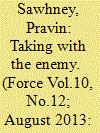

|
|
|
|
|
| Publication |
2013.
|
| Summary/Abstract |
Should India talk with Pakistan's chief of army staff (COAS)? While most in Delhi will dismiss this idea as asinine, the US nearly pulled this rabbit out of the hat in December 2010.
Writing in his recent book, The Dispensable Nation, Vali Nasr, who was senior advisor to Ambassador Richard Holbrooke, the US special representative for Afghanistan and Pakistan, says that "Holbrooke had persuaded General Kayani to agree in principle to talks with India over Afghanistan and Afghanistan only." With this assurance, Holbrooke met the Indian diplomat (unnamed) over dinner in the US on 6 December 2010. According to Nasr, the Indian diplomat took this message to Delhi, and "shortly thereafter, a message came from Delhi that Singh (Prime Minister Manmohan Singh) had given the green light". The meeting never took place as Holbrooke died within a week.
|
|
|
|
|
|
|
|
|
|
|
|
|
|
|
|
|
|
|
|
|